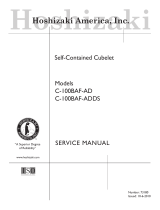
16
8) Ice Purge Cycle – "GM" LED is on. 5-sec. GM delay timer terminates. GM and CCR
energize. Once CCR energizes, 5VDC circuit closes through CCR terminal #3 (W/O)
and terminal #5 (W/O) and CB K9 #5 (W/O) and K9 #6 (W/O). After 5VDC circuit
closes, 5-min. ice purge timer starts. Tobypass the 5-min. Ice Purge Cycle, press the
"SERVICE" button on CB after the "GM" LED turns on. WARNING! Risk of electric
shock. Care should be taken not to touch live terminals. Diagnosis: If "GM" LED is
off, check that UFS closes and WV de-energizes. IfUFS is closed, 30 sec. has passed,
and "GM" LED remains off, replace CB. If"GM" LED is on and GM is off, check CB K1
#2 (BK) to a neutral (W) for 115VAC. If115VAC is not present, check 115VAC power
supply. If115VAC is present, check CB K1 #3(P) to a neutral (W). If 115VAC is present
on CB K1 #2 (BK) and not on CB K1 #3 (P), replace CB. If115VAC is present on CB
K1#3 (P), check GM external overload (reset) or fuse (replace), GM internal protector,
GM windings and capacitor, and GM coupling between auger and GM. When GM
energizes, CCR energizes starting 5-min. ice purge timer.
9) Freeze Cycle – "COMP" and "GM" LEDs are on. The 5-min. ice purge timer
terminates. GM and CCR continue. Comp and FM energize. Ice production starts 4to
6 min. after Comp energizes depending on ambient and water conditions. As ice is
produced, the water level in the reservoir drops. UFS opens. Nothing happens at this
time. When LFS opens, WV energizes and rell cycle begins, FZT terminates, and
FTstarts.
FZT: 30-Min. Freeze Safety Timer – FZT starts when UFS closes and terminates
when LFS opens. If LFS does not open within 30 min. of UFS closing, CB shuts down
the icemaker and sounds a 5-beep alarm. See "III.A.2.LED Lights and Audible Alarm
Safeties." To reset, turn the power supply off and on again. See "II.F. Diagnostic Tables"
for troubleshooting details.
Icemaker Diagnosis (CCR): 5-min. ice purge timer terminates, CB "COMP" LED is
on and COMP and FM energize. If not, check for 5VDC between CB K5 connector pin
closest to CB K4 connector and CB K9connector #5(W/O). If 5VDC is not present,
replace CB. If 5VDC is present, check for 5VDC between CB K5 connector pin closest
to CB K4 connector and CB K9connector #6(W/O). If 5VDC is present and CB "Comp"
LED is off (CR or COMP not energized), replace CB. If 5VDC is not present, check for
115VAC between CCR terminal #7(O) to CCR terminal #8(W) for 115VAC. If115VAC
is not present (GM not energized), see step 8 above. If 115VAC is present and CCR
contacts are open (5VDCpresent between terminals #3(W/O) and #5(W/O)), check
CCR solenoid voltage and solenoid continuity. Replace CCR if necessary.
Icemaker Diagnosis (COMP and FM): If"COMP" LED is on and COMP is not
energized, check CB X1 relay BK wire to a neutral (W) and CB X1 relay V wire to a
neutral (W) for 115VAC. If115VAC is present on CB X1BK wire and not on CBX1 V
wire, replace CB. If115VAC is present on CBX1V wire and COMP is not energized,
check for 115VAC at CB X1 Comp relay. Check Comp internal overload (motor
protector), start relay, and capacitors. If FM does not start, check FM capacitor, FM
windings, and FM bearings.























